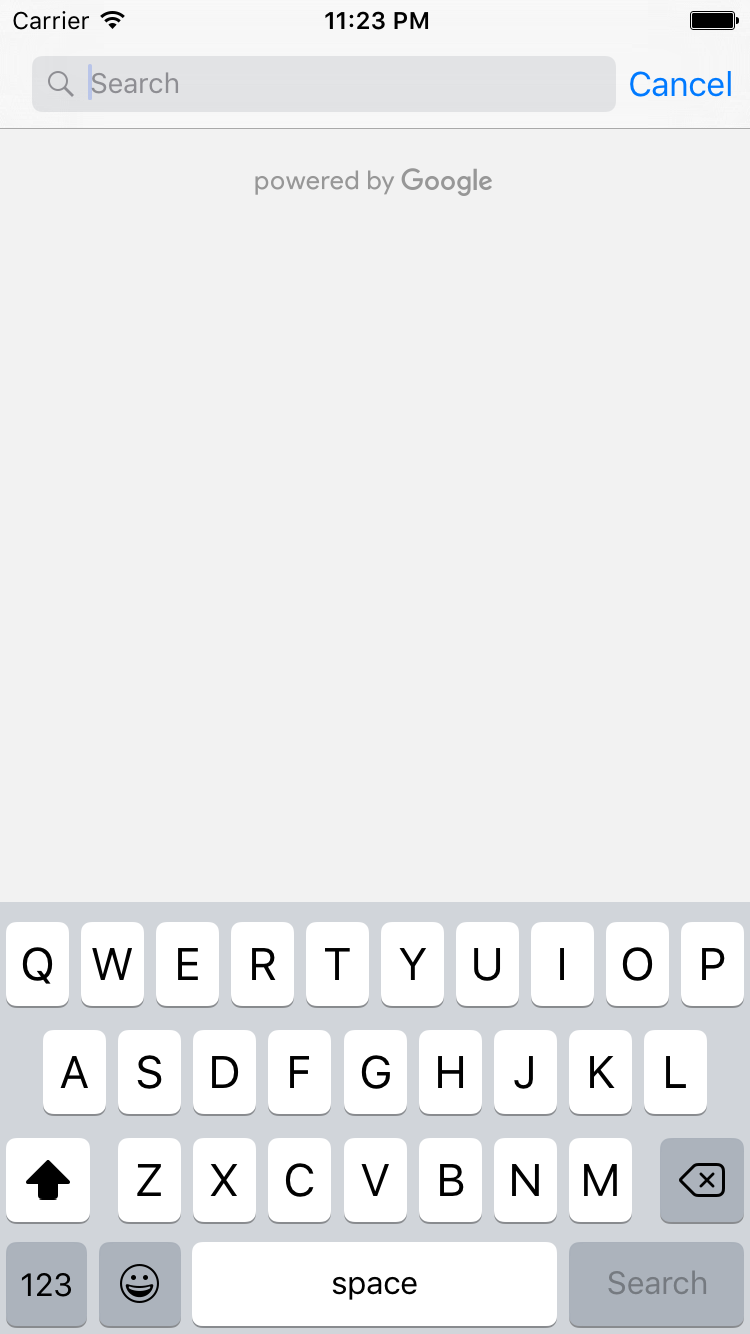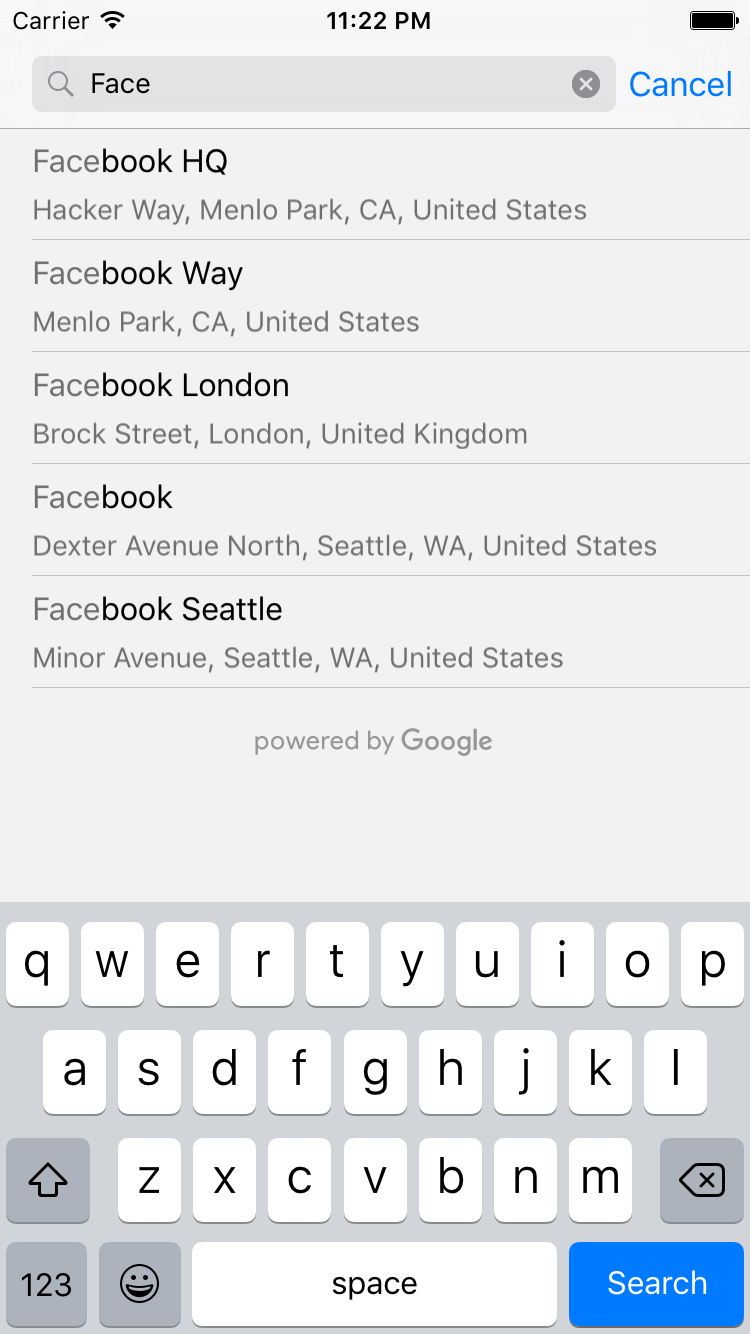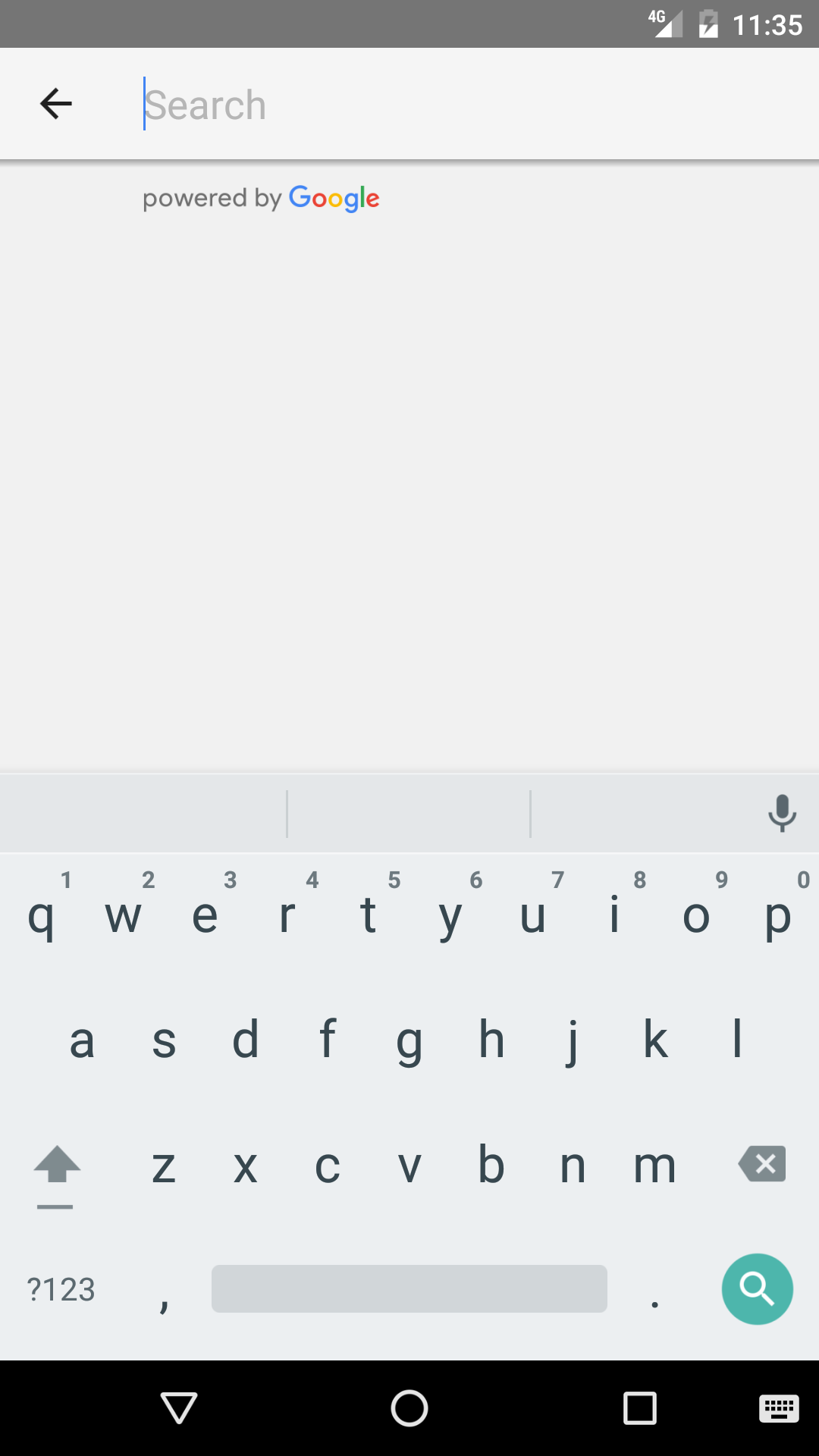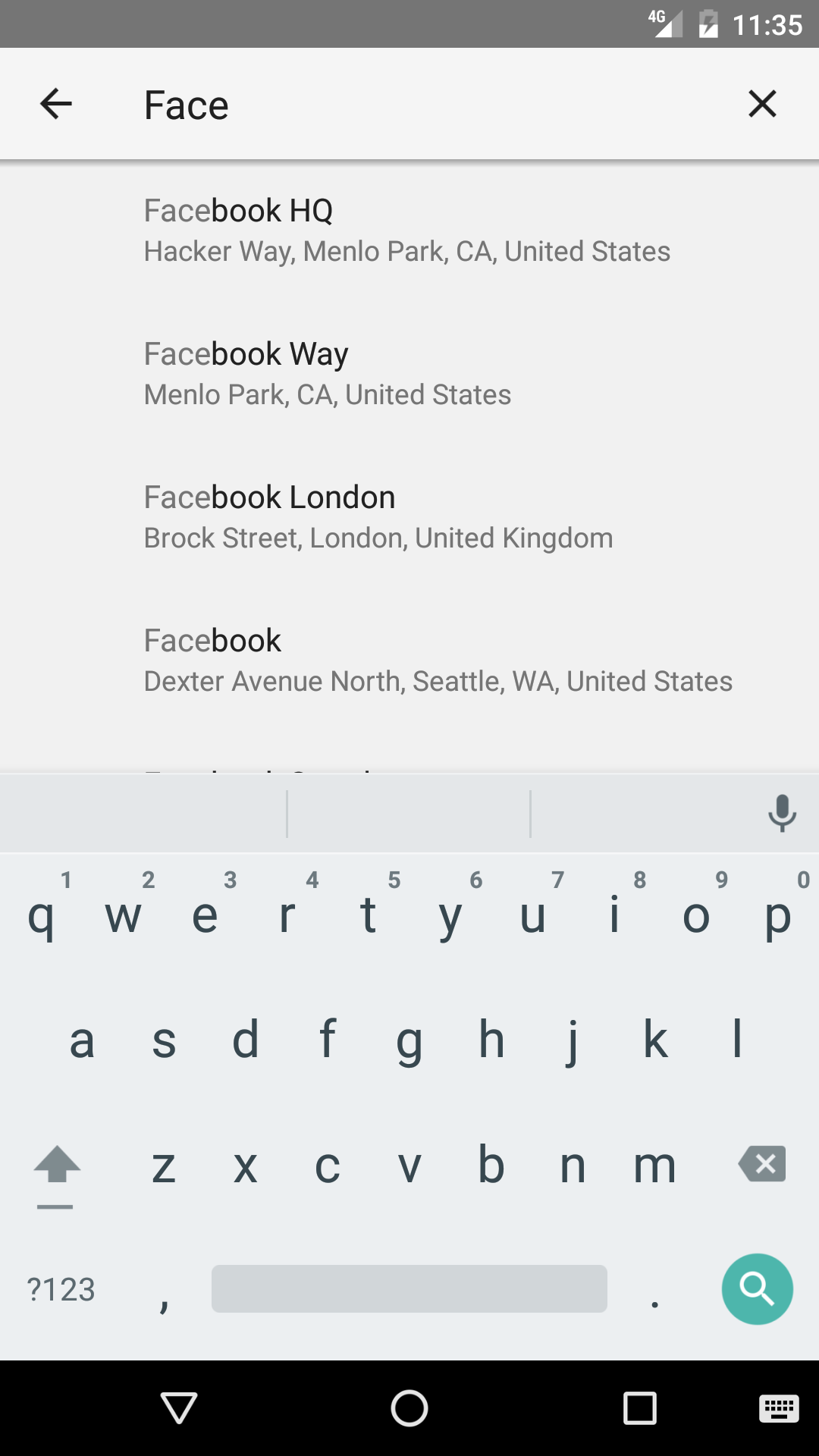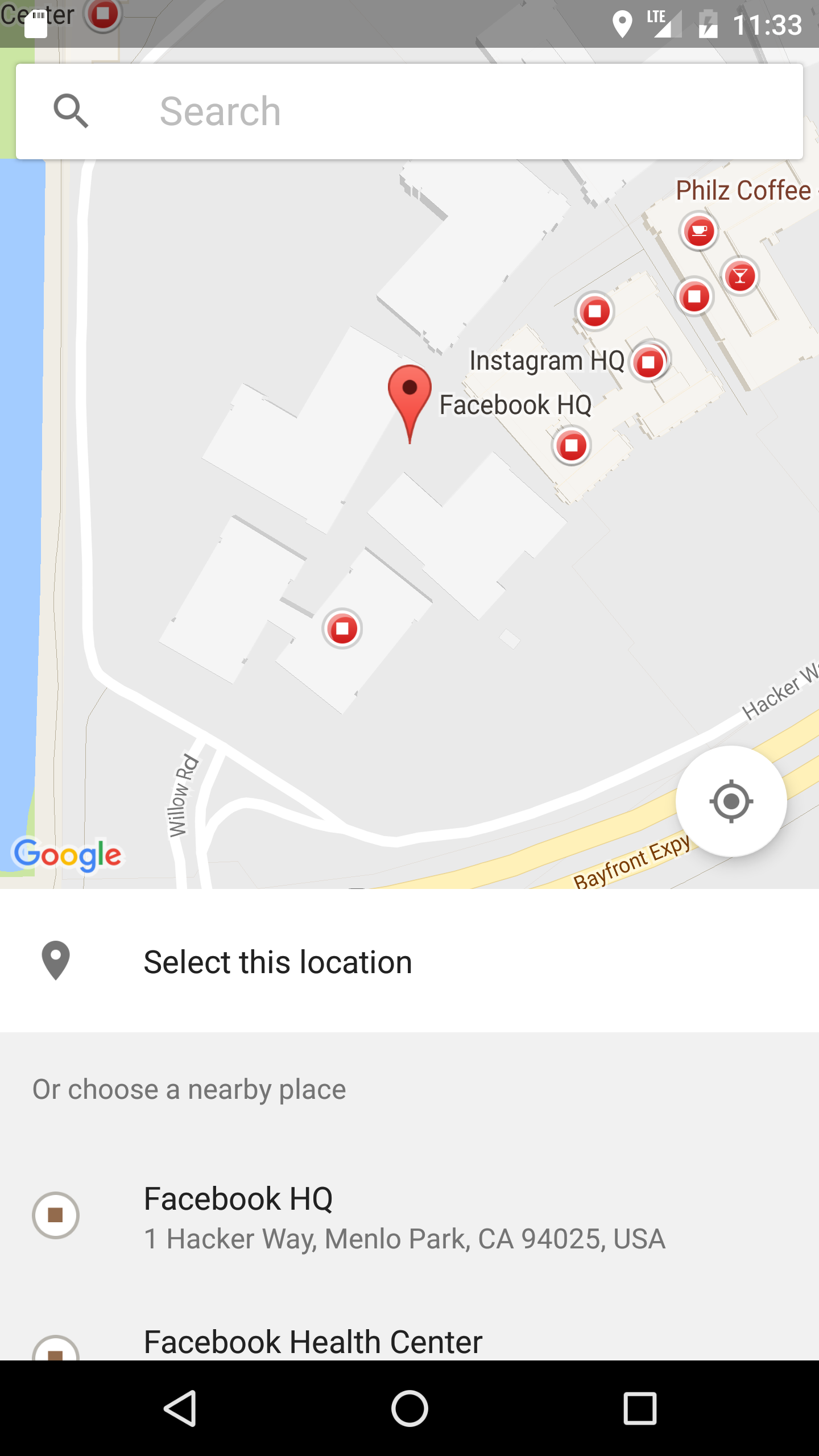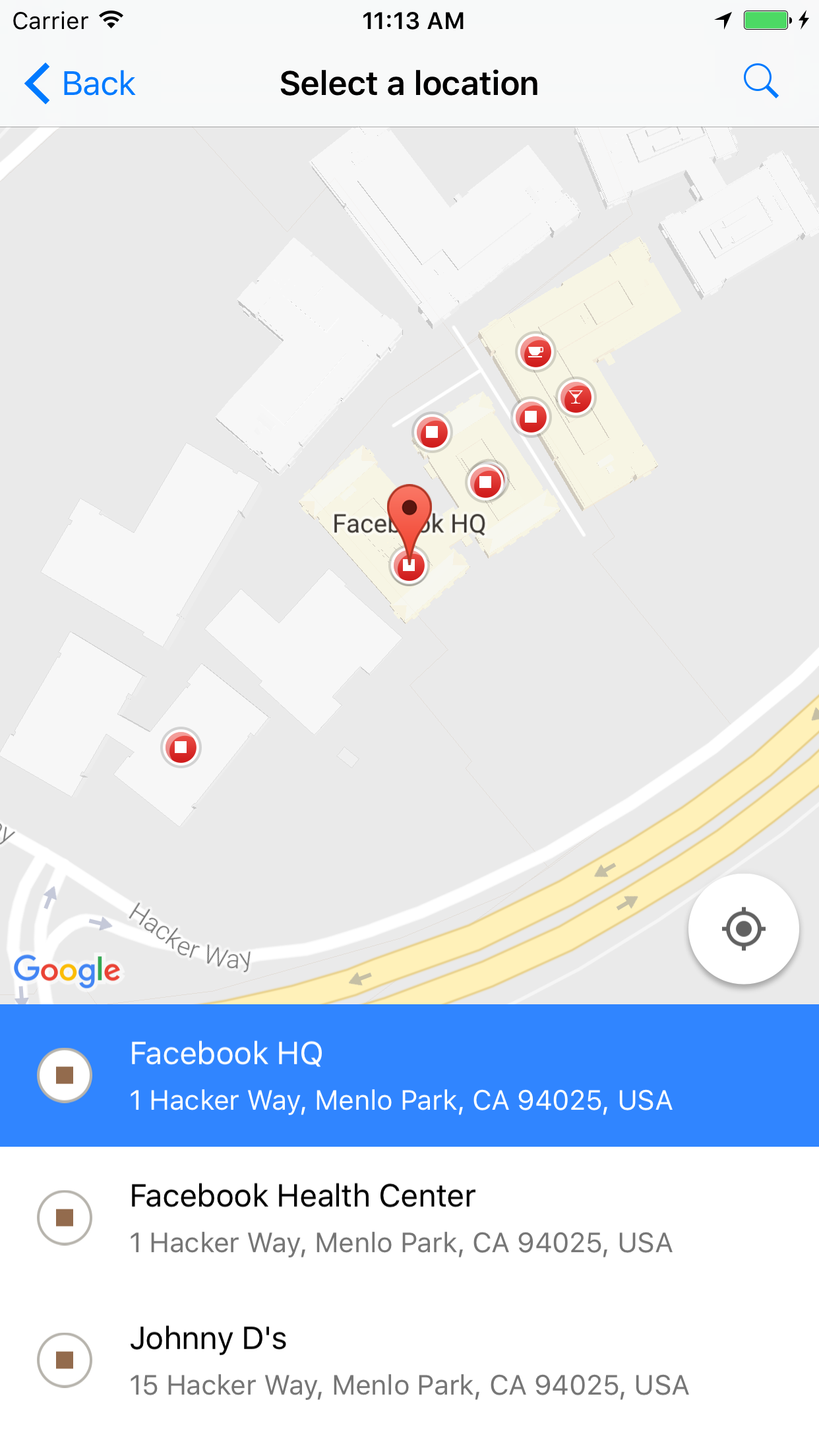react-native-google-places
iOS/Android Google Places Widgets (Autocomplete, Place Picker) and API Services for React Native Apps
Shots
Versioning:
- for RN >=0.40.0, use v2+ (e.g. react-native-google-places@2.0.3)
- for RN (0.33.0 - 0.39.0), use v1+ or 0.8.8 (e.g. react-native-google-places@1.0.3)
Install
npm i react-native-google-places --save
react-native link react-native-google-places
OR
yarn add react-native-google-places
react-native link react-native-google-places
Google Places API Set-Up
- Sign up for Google Places API for Android in Google API Console to grab your Android API key (not browser key).
- Read further API setup guides at https://developers.google.com/places/android-api/signup.
- Similarly, sign up for Google Places API for iOS in Google API Console to grab your iOS API key (not browser key).
- Ensure you check out further guides at https://developers.google.com/places/ios-api/start.
- With both keys in place, you can proceed.
Post-install Steps
iOS (requires CocoaPods)
Auto Linking With Your Project (iOS & Android)
- This was done automatically for you when you ran
react-native link react-native-google-places. Or you can run the command now if you have not already.
Manual Linking With Your Project (iOS)
- In XCode, in the project navigator, right click
Libraries ➜ Add Files to [your project's name]. - Go to
node_modules➜react-native-google-placesand addRNGooglePlaces.xcodeproj. - In XCode, in the project navigator, select your project. Add
libRNGooglePlaces.ato your project'sBuild Phases➜Link Binary With Libraries.
Install CocoaPods Dependencies
- If you do not have CocoaPods already installed on your machine, run
gem install cocoapodsto set it up the first time. (Hint: Go grab a cup of coffee!) - If you are not using Cocoapods in your project already, run
cd ios && pod initat the root directory of your project. - Add
pod 'GooglePlaces', (pod 'GooglePlacePicker'only if you are using the PlacePickerModal) andpod 'GoogleMaps'to your Podfile. Otherwise just edit your Podfile to include:
source 'https://github.com/CocoaPods/Specs.git'
target 'YOUR_APP_TARGET_NAME' do
pod 'GooglePlaces'
pod 'GoogleMaps'
pod 'GooglePlacePicker'
end- In your AppDelegate.m file, import the Google Places library by adding
@import GooglePlaces;and@import GoogleMaps;on top of the file. - Within the
didFinishLaunchingWithOptionsmethod, instantiate the library as follows:
[GMSPlacesClient provideAPIKey:@"YOUR_IOS_API_KEY_HERE"];
[GMSServices provideAPIKey:@"YOUR_IOS_API_KEY_HERE"];- By now, you should be all set to install the packages from your Podfile. Run
pod installfrom youriosdirectory. - Close Xcode, and then open (double-click) your project's .xcworkspace file to launch Xcode. From this time onwards, you must use the
.xcworkspacefile to open the project. Or just use thereact-native run-ioscommand as usual to run your app in the simulator.
Android
- In your AndroidManifest.xml file, request location permissions and add your API key in a meta-data tag (ensure you are within the
<application>tag as follows:
<uses-permission android:name="android.permission.ACCESS_FINE_LOCATION" />
<application
android:name=".MainApplication"
...>
<meta-data
android:name="com.google.android.geo.API_KEY"
android:value="YOUR_ANDROID_API_KEY_HERE"/>
...
</application>Manual Linking With Your Project (Android)
- The following additional setup steps are optional as they should have been taken care of, for you when you ran
react-native link react-native-google-places. Otherwise, do the following or just ensure they are in place; - Add the following in your
android/settings.gradlefile:
include ':react-native-google-places'
project(':react-native-google-places').projectDir = new File(rootProject.projectDir, '../node_modules/react-native-google-places/android')- Add the following in your
android/app/build.gradefile:
dependencies {
...
compile project(':react-native-google-places')
}- Add the following in your
...MainApplication.javafile:
import com.arttitude360.reactnative.rngoogleplaces.RNGooglePlacesPackage;
@Override
protected List<ReactPackage> getPackages() {
return Arrays.<ReactPackage>asList(
new MainReactPackage(),
...
new RNGooglePlacesPackage() //<-- Add line
);
}- Finally, we can run
react-native run-androidto get started.
Usage
Allows your users to enter place names and addresses - and autocompletes your users' queries as they type.
Import library
import RNGooglePlaces from 'react-native-google-places';Open Autocomplete Modal (e.g as Callback to an onPress event)
class GPlacesDemo extends Component {
openSearchModal() {
RNGooglePlaces.openAutocompleteModal()
.then((place) => {
console.log(place);
// place represents user's selection from the
// suggestions and it is a simplified Google Place object.
})
.catch(error => console.log(error.message)); // error is a Javascript Error object
}
render() {
return (
<View style={styles.container}>
<TouchableOpacity
style={styles.button}
onPress={() => this.openSearchModal()}
>
<Text>Pick a Place</Text>
</TouchableOpacity>
</View>
);
}
}To filter autocomplete results to a specific place type as listed for Android and iOS in the official docs, you can pass a filterOptions object as a parameter to the openAutocompleteModal() method as follows. The filterOptions object only takes 2 optional keys (type and country). The value of the type key can only be one of (geocode, address, establishment, regions, and cities), while the country key allows you to filter autocomplete results to a specific country using a ISO 3166-1 Alpha-2 country code (case insensitive). If this is not set, no country filtering will take place. Leave off either or both keys to return unfiltered results.
RNGooglePlaces.openAutocompleteModal({type: 'cities', country: 'NG'})
.then((place) => {
console.log(place);
})
.catch(error => console.log(error.message));Open PlacePicker Modal
class GPlacesDemo extends Component {
openSearchModal() {
RNGooglePlaces.openPlacePickerModal()
.then((place) => {
console.log(place);
// place represents user's selection from the
// suggestions and it is a simplified Google Place object.
})
.catch(error => console.log(error.message)); // error is a Javascript Error object
}
render() {
return (
<View style={styles.container}>
<TouchableOpacity
style={styles.button}
onPress={() => this.openSearchModal()}
>
<Text>Open Place Picker</Text>
</TouchableOpacity>
</View>
);
}
}Example Response from the Autocomplete & PlacePicker Modals
{
placeID: "ChIJZa6ezJa8j4AR1p1nTSaRtuQ",
website: "https://www.facebook.com/",
phoneNumber: "+1 650-543-4800",
address: "1 Hacker Way, Menlo Park, CA 94025, USA",
name: "Facebook HQ",
latitude: 37.4843428,
longitude: -122.14839939999999
}- Note: The keys available from the response from the resolved
Promisefrom callingRNGooglePlaces.openAutocompleteModal()are dependent on the selected place - asphoneNumber, websiteare not set on allGoogle Placeobjects.
Using Your Own Custom UI/Views
If you have specific branding needs or you would rather build out your own custom search input and suggestions list (think Uber), you may profit from calling the API methods below which would get you autocomplete predictions programmatically using the underlying iOS and Android SDKs.
Get Autocomplete Predictions
RNGooglePlaces.getAutocompletePredictions('facebook')
.then((results) => this.setState({ predictions: results }))
.catch((error) => console.log(error.message));To filter autocomplete results to a specific place type as listed for Android and iOS, you can pass a filterOptions object as a second parameter to the getAutocompletePredictions() method as follows. The filterOptions object only takes 2 optional keys (type and country). The value of the type key can only be one of (geocode, address, establishment, regions, and cities), while the country key allows you to filter autocomplete results to a specific country using a ISO 3166-1 Alpha-2 country code (case insensitive). If this is not set, no country filtering will take place. Leave off either or both keys to return unfiltered results.
RNGooglePlaces.getAutocompletePredictions('Lagos', { type: 'cities', country: 'NG' })
.then((results) => this.setState({ predictions: results }))
.catch((error) => console.log(error.message));OR
RNGooglePlaces.getAutocompletePredictions('Lagos', { country: 'NG' })
.then((results) => this.setState({ predictions: results }))
.catch((error) => console.log(error.message));Example Response from Calling getAutocompletePredictions()
[ { primaryText: 'Facebook HQ',
placeID: 'ChIJZa6ezJa8j4AR1p1nTSaRtuQ',
secondaryText: 'Hacker Way, Menlo Park, CA, United States',
fullText: 'Facebook HQ, Hacker Way, Menlo Park, CA, United States' },
{ primaryText: 'Facebook Way',
placeID: 'EitGYWNlYm9vayBXYXksIE1lbmxvIFBhcmssIENBLCBVbml0ZWQgU3RhdGVz',
secondaryText: 'Menlo Park, CA, United States',
fullText: 'Facebook Way, Menlo Park, CA, United States' },
...
]Look-Up A Place By ID
RNGooglePlaces.lookUpPlaceByID('ChIJZa6ezJa8j4AR1p1nTSaRtuQ')
.then((results) => console.log(results))
.catch((error) => console.log(error.message));Example Response from Calling lookUpPlaceByID()
{ name: 'Facebook HQ',
website: 'https://www.facebook.com/',
longitude: -122.14835169999999,
address: '1 Hacker Way, Menlo Park, CA 94025, USA',
latitude: 37.48485,
placeID: 'ChIJZa6ezJa8j4AR1p1nTSaRtuQ',
phoneNumber: '+1 650-543-4800'
}Design Hint
The typical use flow would be to call getAutocompletePredictions() when the value of your search input changes to populate your suggestion listview and call lookUpPlaceByID() to retrieve the place details when a place on your listview is selected.
PS (from Google)
- Use of the
getAutocompletePredictions()method is subject to tiered query limits. See the documentation on Android & iOS Usage Limits. - Also, your UI must either display a 'Powered by Google' attribution, or appear within a Google-branded map.
Troubleshooting
On iOS
You have to link dependencies and re-run the build:
- Run
react-native link - Try
Manual Linking With Your Projectsteps above. - Run
react-native run-ios
On Android
- Run "android" and make sure every packages is updated.
- If not installed yet, you have to install the following packages:
-
Extras / Google Play services
-
Extras / Google Repository
-
Android (API 23+) / Google APIs Intel x86 Atom System Image Rev. 13
-
Check manual installation steps
-
Ensure your API key has permissions for
Google PlaceandGoogle Android Maps -
If you have a different version of play serivces than the one included in this library (which is currently at 9.8.0), use the following instead (switch 10.0.1 for the desired version) in your
android/app/build.gradefile:... dependencies { ... compile(project(':react-native-google-places')){ exclude group: 'com.google.android.gms', module: 'play-services-base' exclude group: 'com.google.android.gms', module: 'play-services-places' exclude group: 'com.google.android.gms', module: 'play-services-location' } compile 'com.google.android.gms:play-services-base:10.0.1' compile 'com.google.android.gms:play-services-places:10.0.1' compile 'com.google.android.gms:play-services-location:10.0.1' }
License
The MIT License.
